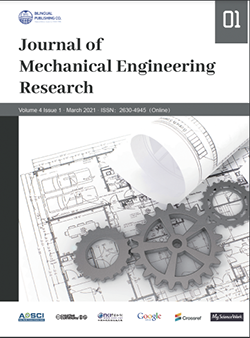Evaluation of Vibration Amplitude Stepping and Welding Performance of 20 kHz and 40 kHz Ultrasonic Power of Metal Welding
DOI:
https://doi.org/10.30564/jmer.v4i1.2940Abstract
Today ultrasonic power technique is consider a mandatory technique which is always entered in many processes such as in metal and plastic welding to overcomes many issues, with aided of applying force (pressure) and supplied high frequency vibration, a solid-state weld can be generated by ultrasonic metal welding technique. That gives a technique the ability to join not only a small component, whereas also to join thicker specimens, which depends on a proper control of matching welding conditions. Therefore a welding performance can be studied and compared after designed welding horn to resonance at frequencies of 20 kHz and 40 kHz. The analyses of the designed horn are completed through use a vibration mathematical expressions, modal and harmonic analyses to ensure the weldability due to applying ultrasonic power to the working area and also to compare the performance of joint at using two resonance frequencies of 20 kHz and 40 kHz. The dimensions of the horns were determined to match the selected resonance frequencies, which the lengths were calculated as 132 mm and 66 mm respectively. The analysis of the exciting model indicates that the axial vibration modes of 19,584 Hz and 39,794 Hz are obtained in 10th mode, while the two frequency values are recorded 19,600 Hz and 39,800 Hz from the frequency response of the two horns. The weld strength between Al and Cu specimens with a thickness 0.5 mm was evaluated using a tensile test, which the analyses were obtained under using different welding pressure and varied amplitudes. The results were recorded within exciting a horn with two different resonance frequencies, show the enhancement of weld strength and quality through control of stepping amplitude, the enhancement means obtain good strength of the weld, reduce sticking horn to specimen, and lower specimen marking.
Keywords:
Ultrasonic welding; Horn design; Vibration amplitude; Stepping amplitude; Welding performanceReferences
[1] E. deVries, 2004, Mechanics and Mechanisms of Ultrasonic Metal Welding, PhD Thesis Ohio State University.
[2] K. Graff, 2005, Ultrasonic Metal Welding, in New Developmets in Advanced Welding Cambridge, 241- 269.
[3] M. Bloss and K. Graff, 2009, Ultrasonic Metal Welding of Advanced Alloys: The Weldability of Stainless Steel, Titanium, and Nickel-Based Superalloys, Trends in Welding Research Proceedings of the 8th International conference, ASM International.
[4] S. Kim, H. Sung, E. Kim and D. Park, 2010, Vibration Analysis of Ultrasonic Metal Welding Horn For Optimal Design, Proceedings of the International Conference on Mechanical, Industrial, and Manufacturing Technologies, Sanya China.
[5] Ziad Sh. Al Sarraf, 2012, Enhancement Weld Strength Due to the Control of Amplitude Profiling For Joining Metals by Ultrasonic, Unpublished.
[6] ASTM International Codes, 2009, Standard Test Methods for Tension Testing of Metallic Materials, 1-24.
[7] British Standard Codes, 2009, Test Pieces and Test Methods for Metallic Materials for Aircraft, Metric units 1-7.
[8] Ziad Sh. Al Sarraf, Majid M. Chilmeran, 2018, Design and Analysis of Slotted Block Horn Used For Ultrasonic Power Applications. Journal of Southwest JIAOTONG University, Vol , No. DOI: 10. 3969 /j, ISSN. 0258-2724.
[9] M. Hiraishi and T. Watanabe, 2003, Improvement of Ultrasonic Weld Strength for Al-Mg Alloy by Adhesion of Alcohol - Ultrasonic Welding of Al-Mg Alloy, Quarterly Journal of the Japan Welding Society, 21(2), 295-301.
[10] M. Baboi and D. Grewell, Evaluation of Amplitude Stepping in Ultrasonic Welding, Welding Journal, Sponsored by the American Welding Society and the Welding Research Council, 2010.
Downloads
Issue
Article Type
License
Copyright © 2021 Ziad Shakeeb Al Sarraf

This is an open access article under the Creative Commons Attribution-NonCommercial 4.0 International (CC BY-NC 4.0) License.




 Ziad Shakeeb Al Sarraf
Ziad Shakeeb Al Sarraf

